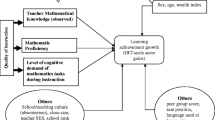Abstract
This paper presents a curriculum, textbook and test result analysis for the new (to California) elementary school “Key Standard” mathematics curriculum, transplanted in 1998 from it's foreign roots in Asia and Europe, locations with far different cultural and economic backgrounds. Based on topic analysis methods developed by Michigan State University, this curriculum is a “quality” curriculum, since it is closely aligned with the curriculum of the six leading TIMSS math countries. Five-year test results are presented for two cohorts totaling over 13,000 students, all from four “early adoption” urban districts where 68% of the students were economically disadvantaged. Included are two cohorts of English learning immigrants totaling over 4,400 students. Performance was found to be statistically superior to similar (control) districts which continued with the old 1991 curriculum and textbooks (0.003 < p < 0.015). The focus of this paper is on the transition from far-below to above average learning performance of these students over the 1998–2002 period.
Similar content being viewed by others
References
Bishop, W.: 2002, ‘Four years of California mathematics progress’, http://www.teachutahkids.com/fouryears-ca.asp.
Bishop, W. and Hook, W.: 2004, ‘Urban elementary schools in California show stunning improvement in SAT-9 test scores over initial four year period of new math standards’, http://www.nychold.com/report-wbwh-040619.pdf.
Kauffman, D., Johnson, S.M., Kardos, S.M., Liu, E. and Peske, H.G.: 2002, ‘Lost at sea – Without a curriculum, navigating instruction can be tough’, American Educator, Summer 2002 Issue http://www.aft.org/pubs-reports/american_educator/summer2002/lostatsea.html.
Klein, D.: 2003, in J. Royer (ed.), A brief history of American K-12 mathematics education in the 20th century, chapter 7 of Mathematical cognition: A volume in current perspectives on cognition, learning, and instruction, Information Age Publishing.
Leung, F.S.K.: 2005, ‘Some characteristics of east Asian mathematics classrooms based on data from the TIMSS 1999 video study’, Educational Studies in Mathematics 60, 199–215.
Ma, L.: 1999, Knowing and teaching elementary arithmetic, Lawrence Erlbaum Associates, Mahwah, New Jersey.
Quick, H., Birman, B., Gallagher, L., Wolman, J., Chaney, K. and Hikawa, H.: 2003, Evaluation of the blueprint for student success in a standards-based system: Year 2 interim report, American Institute for Research, Palo Alto http://www.air.org/projects/projects_ehd_school_reform.aspx.
Schmidt, W., Houang, R. and Cogan, L.: 2002, ‘A coherent curriculum, the case of mathematics’, American Educator, Summer 2002 Issue, http://www.aft.org/pubs-reports/american_educator/summer2002/curriculum.pdf.
Author information
Authors and Affiliations
Corresponding author
Rights and permissions
About this article
Cite this article
Hook, W., Bishop, W. & Hook, J. A Quality Math Curriculum in Support of Effective Teaching For Elementary Schools. Educ Stud Math 65, 125–148 (2007). https://doi.org/10.1007/s10649-006-9050-4
Published:
Issue Date:
DOI: https://doi.org/10.1007/s10649-006-9050-4
Keywords
- elementary school math
- international math
- TIMSS topics analysis methods
- TIMSS quality math curricula
- California math curriculum
- California math 5 year test results
- performance rate improvement analysis
- independent sample t-test
- effective math teaching
- disadvantaged students
- English learning immigrant students
- urban elementary schools
- suburban elementary schools
- transition to a rigorous curriculum




